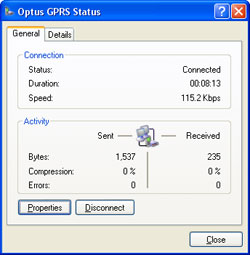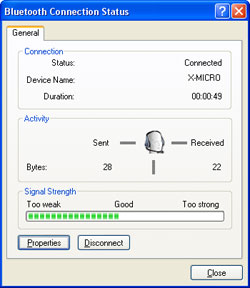|
|
Advertisement:
|
|
X-Micro Bluetooth Class 2 USB Dongle |
|
Join the community - in the OCAU Forums!
|
Modem, Range & Performance, Conclusion
Modem (GSM phone)
Bluetooth equipped mobile phones often offer a “Fax/Modem” service, which allows you to use them to connect to the Internet (or other data services) via the GSM/GPRS/UMTS networks. Team this with a notebook computer and you have a truly mobile workstation.
When browsing the services on the Nokia 7650, "Dial Up Networking", "Bluetooth Serial Port" and "Fax" were available. Interestingly, the first two failed to connect properly (I would receive errors such as "The remote device has closed the connection"). These errors seemed to be a quirk of the phone - as the serial port (as described earlier) worked with the other PC. When connecting the Fax, this would enable the "Bluetooth Fax Modem", which had been installed by the Bluetooth software.


I was able to use Hyperterminal to connect to this modem, and type in GSM AT commands to the phone’s terminal. I also was able to create dial-up networking connections and dial both circuit-switched ISDN services (such as regular ISPs) as well as dial the *99# number, which activates the phone’s GPRS Internet connection.

This service would clearly be very useful on the move (with a notebook) as, unlike IrDA, where you have to keep the phone in-line with the IR port, you can leave the phone in your pocket (which also removes the security risk of having the phone snatched).
Range & Performance
The X-Micro USB dongle was able to obtain a reasonable range with the other Class 3 and Class 2 devices, typically around 10-15m in the indoor environment. The transfer speed dropped as distance increased due to additional FEC (Forward Error Correction) overhead and retransmission of failed packets. Whilst this was still suitable for file transfer (I was able to transfer a file to the mobile phone on the other side of the house, although very slowly), audio became very choppy so its practical range was somewhat smaller.
The current signal strength can be found in the ‘Status’ dialog of any Bluetooth connection. I did notice the bar graph fluctuated frequently (when stationary), so I’m not sure how accurate the reading is.

A potential problem with Bluetooth devices is interference with 802.11b and 802.11g which operate on the same spectrum. I normally operate 802.11g devices in the test area, which were shut off for the most part of the Bluetooth testing, however I turned them on to observe how the interference affected the performance of this device as well as the 802.11g network.
In the past I have had interference issues with the older 802.11b, such as that when a Bluetooth device was sending data, the 802.11b throughput would drop right down. However, with 802.11g and Bluetooth devices operating simultaneously in the same area, I can’t say I noticed any noticeable drop in performance doing everyday tasks such as web browsing, playing music & videos (from network drives) etc. It’s still something to be cautious of, however, when using the two technologies together.
As for transfer speeds, 1Mbit was never achieved. This is theoretically impossible, because this is the raw symbol rate (GFSK modulates 1 bit per symbol). However, Bluetooth has considerable overheads associated with headers, FEC, etc. The rates that were achieved (often around 700kbps) were still acceptable for the tasks most people would want to use Bluetooth for.
It was not always possible to use multiple devices in various combinations simultaneously. For example, if I had a headset connection with the notebook, the notebook would not accept incoming file transfers. But, if the file transfer was put in progress first, and the headset then connected, the two services would work fine. When using the headset and file transfer simultaneously, because the headset is a SCO (Synchronous Connection Oriented) link, its bandwidth is reserved and thus there was no interruption to the audio. The file transfer speed dropped, however.
Conclusion
The X-Micro Bluetooth Class 2 USB Dongle was able to consistently deliver Bluetooth functionality. It was able to successfully demonstrate a collection of Bluetooth services and interface with devices including a PC, mobile phone and headset.
The WIDCOMM Bluetooth software and drivers bundled with the device proved to be very reliable and withstood numerous hot removals and insertions of the USB adapter, as well as Hibernate and Sleep cycles, without problems. The Bluetooth services could also be used by all users on the PC, including users with restricted accounts. This was a welcome change from the amount of software that fails to run as anyone other than Administrator.
The X-Micro Class 2 USB Dongle is recommended for anyone needing to connect to existing Bluetooth devices from a PC - and it does it quickly and easily. An RRP of USD $32 makes it a competitively priced solution. Altech Computers distribute X-Micro products in Australia.
|
|
Advertisement:
All original content copyright James Rolfe.
All rights reserved. No reproduction allowed without written permission.
Interested in advertising on OCAU? Contact us for info.
|

|


